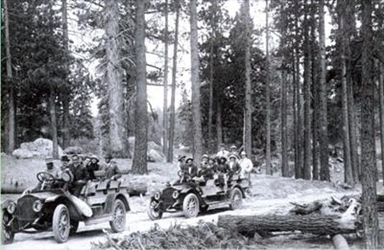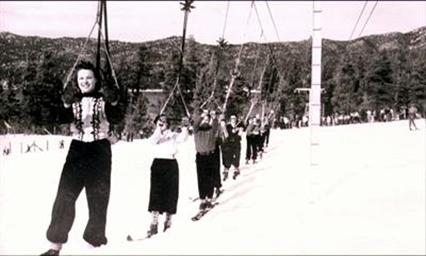A Resort Destination
Big Bear's first hotel was built in 1888 by 21 year-old, Gus Knight Jr. who realized that the new lake would bring tourists to the area. Knight, along with partner John Metcalf, purchased 80 acres south of the lake and in June opened the 30 guest, Bear Valley Hotel. Unfortunately the hotel was destroyed by fire in 1900. Automobiles started making the trip to Bear Valley as early as 1909, Charles Henry (the brother-in-law of Gus Knight) rebuilt the Bear Valley Hotel and in 1906 a group of wealthy investors from Redlands, purchased the hotel along with the surrounding 112 acres and changed the name to the Pine Knot Lodge. The Pine Knot Lodge was considered luxurious mountain living and was host to many movie companies while they were working in the area. The lodge closed in 1928.
After his Bear Valley Hotel burned in 1900, Gus Knight filed for bankruptcy. In 1906 he inherited 40 acres east of Pine Knot and built Knights Camp which he opened in 1915. Located on the south shore of the Lake , the resort featured separate cabins, central dining hall, dance hall, store, and a fleet of motor and row boats.
After 1915 the government began leasing summer home sites near the dam for $15 a year. These sites were along both the north and south side of the lake. Many of these picturesque cabins remain today, and some are owned by the same families that built them. Since there were no roads to this area at the time, all the lumber and supplies had to be brought over by boat.
In 1917, Albert Brush began construction of the Big Bear Lake Tavern. The resort consisted of a main building, four large guest quarters, thirty separate cabins, employee quarters, lighting plant, garage and a stable. A movie company used the tavern for a location soon after it was completed. The property still exists and is now known as the Presbyterian Conference Center.
In 1921 Carl and Mamie Stillwell opened the famous Stillwells Lodge and Ballroom, which became known throughout Southern California for good music, dancing, and a lakeside setting in the forest. The lodge had a beach, swimming pool, restaurant, tennis courts and boat landing and soon became the Mecca in the mountains for young and old. Top-name radio and recording bands played over the years. Motion picture companies often stayed there when on location, and the pavilion was used in several films. The original ballroom was destroyed by fire in 1928 and was replaced with a new structure.
In 1921 Emile Jesserun purchased 40 acres of Shay Ranch land which included a natural hot spring that had been used by the Serrano Indians. In 1924 Emile opened the Pan Hot Springs Inn, one of the largest hotels in the valley. The Inn had two large swimming pools, one indoor and one outdoor, and the pools were filled with hot, naturally flowing mineral water. The Inn also featured a lavish ballroom with a medieval decor.
The resort was frequented by celebrities and movie companies until it was destroyed by fire in 1933. Later, a new smaller pool was built and it continued to operate until it too was damaged by the 1992 Big Bear earthquake. The pool never re-opened.
By 1924, forty-four resorts were in full operation and all were supplied with electricity. On the 4 th of July that year 10,000 cars poured into Big Bear Lake.
In 1925 Harry Kiener, the creator of The Peter Pan Woodland Club formed a corporation to develop mountain property in the east valley area of Big Bear City (just east of the present day airport).
In 1930, Guy Maltby, owner of the Bear Valley Milling And Lumber Company designed and built the huge four-story clubhouse surrounded by a a golf course, beautiful landscaping, tennis courts, swimming pool, and gymnasium. The symbol of the club was a beautiful statue of Peter Pan sitting on a huge mushroom in the garden. The Peter Pan Woodland Clubhouse was a showplace and host to many gala parties, and was the center of social life in Big Bear City .
Several movies used the clubhouse for a backdrop and the club was a favorite with movie companies on location in the valley. The clubhouse was destroyed by fire in 1948.




